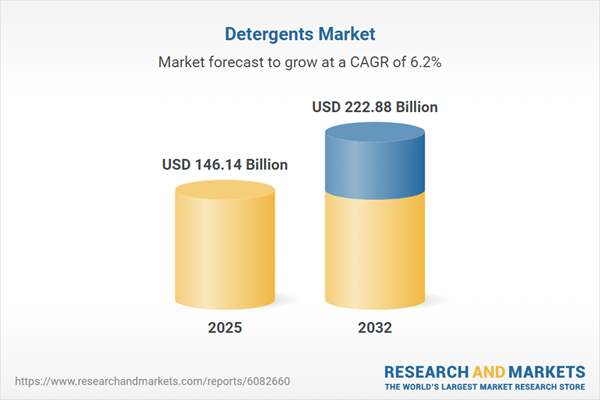Speak directly to the analyst to clarify any post sales queries you may have.
The detergents market is evolving rapidly, shaped by emerging technologies, shifting consumer expectations, and regulatory pressures. Understanding current trends and regional dynamics enables senior decision-makers to navigate growth opportunities and competitive challenges strategically.
Market Snapshot: Detergents Market Revenue and Growth
The detergents market grew from USD 137.75 billion in 2024 to USD 146.14 billion in 2025, and is expected to reach USD 222.88 billion by 2032, expanding at a CAGR of 6.19%. This sustained momentum is propelled by innovation in formulations, rising consumer demand for eco-friendly products, and advances in packaging and distribution strategies.
Scope & Segmentation of the Detergents Market
- Product Forms: Liquid (both concentrated and standard), pods/capsules (multi-chamber and single-chamber), powders (compact and standard), and tablets (pre-wash and regular).
- Ingredient Types: Bio-based (enzyme-based and plant-based), eco-friendly (phosphate-free and sulfate-free), and synthetic options (amphoteric, anionic, cationic, nonionic).
- Fragrance Profiles: Citrus, floral, fresh, and scent-free options designed to address different consumer preferences and sensitivities.
- Formulation Technologies: Biological and non-biological systems enable customized cleaning efficiency and allergen management.
- Packaging Types: Refillable and rigid plastic bottles, boxes, capsule packs, and pouches supporting sustainability and brand differentiation.
- End Uses: Suitable for automatic washing machines (front load, top load) and manual hand washing, addressing both commercial and residential needs.
- Applications: Household and industrial/commercial.
- Distribution Channels: Convenience stores, online retail (brand websites, e-commerce platforms), supermarkets, hypermarkets, and wholesale outlets.
- Regional Coverage: Americas (North America and Latin America), Europe, Middle East & Africa, Asia-Pacific—each region presenting distinct market drivers and consumer trends.
- Company Profiles: Includes The Procter & Gamble Company, Unilever PLC, Henkel AG & Co. KGaA, Church & Dwight Co., Ltd., Reckitt Benckiser Group plc, and other leading manufacturers.
Key Takeaways for Senior Decision-Makers
- Sustainability is a strategic focus, with increasing use of enzyme-based, plant-derived, and phosphate-free formulations meeting both regulatory and consumer demands.
- Digital transformation is driving omnichannel strategies, as brands integrate e-commerce growth with traditional channels to reach diverse consumers efficiently.
- Premiumization and health-awareness trends are prompting the emergence of specialized detergents, such as antimicrobial and hypoallergenic variants targeting targeted consumer segments.
- Convenience-led packaging innovations, including single-dose pods and refillable containers, cater to urban lifestyles and reduce packaging waste.
- Regional variation remains critical—with the Americas favoring premium products, Europe focusing on eco-labels, the Middle East addressing water scarcity, and Asia-Pacific driving growth through digital adoption and urbanization.
- Ingredient innovation is a core differentiator, as manufacturers leverage bio-based and synthetic components for enhanced performance and sustainability.
Tariff Impact: U.S. Duties Reshape Raw Material Procurement
United States tariffs imposed in 2025 have increased costs for key ingredients, particularly surfactants and petrochemicals, driving a shift toward alternative feedstocks and bio-based inputs. Manufacturers are restructuring supply chains by nearshoring production, engaging regional suppliers, and renegotiating procurement contracts. These changes are impacting pricing strategies, with premium brands choosing to absorb increases while value-driven competitors pass costs through to end users.
Methodology & Data Sources
This report uses a rigorous methodology, combining detailed desk research from industry publications, regulatory documents, and corporate reports with in-depth primary interviews with executives and procurement leaders. Quantitative surveys and data triangulation further strengthen accuracy and actionable insight generation.
Why This Report Matters
- Provides actionable intelligence grounded in diverse, high-quality data sources, helping leaders identify and act on critical growth opportunities and operational risks.
- Enables benchmarking across technology, ingredient sourcing, regional strategy, and distribution channel optimization to drive sustainable business advantage.
- Supports resilient decision-making amid shifting regulatory, supply chain, and consumer landscapes.
Conclusion
Senior executives and strategic planners can rely on this report for a clear, evidence-based view of how sustainability, digitalization, and supply chain dynamics are redefining the detergents market. Informed decision-making helps organizations anticipate industry shifts and position for sustained success in complex global environments.
Table of Contents
3. Executive Summary
4. Market Overview
7. Cumulative Impact of Artificial Intelligence 2025
List of Figures
Samples

LOADING...
Companies Mentioned
The key companies profiled in this Detergents market report include:- The Procter & Gamble Company
- Unilever PLC
- Henkel AG & Co. KGaA
- Church & Dwight Co., Ltd.
- Reckitt Benckiser Group plc
- Kao Corporation
- Colgate-Palmolive Company
- The Clorox Company
- Ecolab Inc.
- Lion Corporation
Table Information
| Report Attribute | Details |
|---|---|
| No. of Pages | 187 |
| Published | October 2025 |
| Forecast Period | 2025 - 2032 |
| Estimated Market Value ( USD | $ 146.14 Billion |
| Forecasted Market Value ( USD | $ 222.88 Billion |
| Compound Annual Growth Rate | 6.1% |
| Regions Covered | Global |
| No. of Companies Mentioned | 11 |









